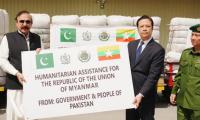The major problem facing Pakistan for the last several decades is the fact that our exports are confined to low value-added goods, whereas the major opportunities lie in high technology (high value added) exports.
Pakistan's biggest exports are cotton and textile products, rice, fruits and vegetables, sports goods, and leather products. These low value-added goods account for about 90 percent of our exports sales. In comparison, the exports of Korea are integrated circuits, cars, passenger and cargo ships, and vehicle parts. In the case of Taiwan, the major exports are electronics, basic metals and metal products, plastics and rubber, chemicals, and machinery.
For India, the major exports again are high value-added goods including engineering goods, petroleum products, gems and jewellery, organic and inorganic chemicals, drugs and pharmaceuticals, electronic goods and software. This illustrates where we have gone wrong and what we must do to change directions so that Pakistan can become a manufacturer and exporter of high value-added high-tech products. A new beginning is urgently needed.
Good vision documents have been prepared in the past including Vision 2010 led by Dr Ahsan Iqbal, Vision 2030 led by Dr Akram Sheikh and the ‘Technology Based Industrial Vision, and Strategy for Pakistan’s Socio-economic Development’ prepared under my charge and approved by the cabinet. These are all excellent documents, but successive governments have lacked the will to implement them. With limited financial resources, it has been a challenging task to define national priorities leading to a knowledge economy. As a result, education, science, technology and innovation have received a backseat, with Pakistan spending only about 2.5 percent of its GDP on education and less than 0.3 percent on science and technology. Science and technology touched a peak of 0.63 percent of GDP in 2007 according to World Bank data but has declined subsequently.
Clearly a new sense of direction and a strong political will are needed. A clear decision needs to be made in order for Pakistan to emerge from the shackles of poverty and ignorance. It has to invest in universal literacy, establish good technical and vocational schools, set up good colleges and high-quality universities with centers of excellence in selected fields. Simultaneously we need to develop strong linkages with industry and take measures to promote innovation and entrepreneurship. Industrial clusters will need to be established in key fields such as industrial biotechnology, pharmaceuticals, engineering goods, electronics, mineral extraction/processing and other high-tech areas.
As a result of clear national policies and strategies, countries such as Singapore, Korea, Taiwan, India and Japan have focused on selected high technology industries instead of low technology items such as textiles. This has resulted in a huge boost to the value of their exports and gave them a strong competitive edge. The recent Covid pandemic, for instance, brought out the fact that the largest world exporter of vaccines against coronavirus was India, which had systematically strengthened its capabilities in basic manufacture of pharmaceuticals including vaccines over the last several decades. In contrast we are unable to manufacture even simple pharmaceuticals such as aspirin, paracetamol or children’s vaccines in Pakistan because of myopic government policies.
Countries such as Korea and Taiwan are now world leaders in the manufacture and export of such high value-added items as automobiles, engineering goods, ship building, electronics and computers. This became possible because private-sector industries were supported by the respective governments. This support was in the form of government incentives to companies to develop capabilities in design, engineering and large-scale manufacturing technologies.
To assist private high-tech industries to develop and flourish, semi-government bridging institutions were also established. Financial assistance was thus provided to private companies to facilitate the transfer of cutting-edge technologies from abroad. Technology parks, industrial parks and incubation centers were set up in the vicinity of high-tech industrial clusters to facilitate the manufacturing processes. Links with diaspora abroad were also facilitated by the government, to help transfer of key technologies.
A major issue faced by Pakistan is that almost all R&D is done by institutions under the government sector, with private-sector R&D making an insignificant contribution. This matter needs to be aggressively tackled. In most advanced countries the percentage of R&D expenditure in the private sector is much greater than that in the government sector. To facilitate this transition, the government could bring out schemes under which 200 percent or even 300 percent tax breaks would be given to industrial firms if they were to establish research and development laboratories and undertake genuine R&D expenditure within their companies.
China, India and some East Asian countries implemented such policies and stimulated demand for innovation through promoting firm-level learning. Government incentives were given to private companies for hiring skilled engineers and researchers. Tax incentives were offered for the establishment of high-tech industries. Strong quality control measures were introduced through strictly monitored regulations to ensure that a minimum quality of exports was guaranteed. Fast dispute resolution was introduced through special commercial courts so that rapid settlements of court cases was achieved. The introduction of proper competition laws helped to foster innovation and encourage competition for both exports and for import substitution programs.
In order to go down this path, robust innovation policies must also be put in place to ensure competitiveness, industrial development and growth of exports. These policies should create demand for innovation and promote capabilities for developing indigenous technologies. University-industry linkages need to be strengthened, pilot plant facilities established with government support to help demonstrate the feasibility of many new processes on a larger scale, intellectual property right regimes strengthened and liberal access to venture capital provided so that ideas can be translated into products and processes. At present, university faculty members in Pakistan are not allowed to work in industries. This must be changed, as is the case in Japan, Korea and many other fast developing countries where it is common for university faculty members to work as consultants to industry.
Pro-poor innovation policies should receive particular focus. This is illustrated by the motor bike manufacturing programme in China. In 1998, there were only 12 motorbike manufacturing plants producing 56,000 motorbikes annually. Through a determined government effort directed at promoting this sector, the number of manufacturing units grew from 12 to 2000 by 2010, and the number of units being manufactured grew to 30 million units annually, over 80 percent of which was for the domestic market.
For Pakistan, the writing is very much on the wall. We must change course and focus on the new opportunities that the Fourth Industrial Revolution has opened up.
The writer is chairman PM National Task Force on Science and Technology, former minister, and former founding chairman of the HEC.
He can be reached at: ibne_sina@hotmail.com
This demand has fueled rapid growth deposit base of Islamic Banks and Islamic Windows operated by conventional banks
But Punjab Agriculture Food and Drug Authority building near Thokar Niazbeg on Multan Road stands out
Macron has been particularly vocal in their criticism, asserting that withholding arms from Kyiv plays directly into...
As PPP governs province, Bilawal Bhutto Zardari holds strategic position to address both violence and its underlying...
Critics argue that strategy is vague, but closer look indicates strategic alignment with global trends and national...
To defeat it, we must distrust bot-driven narratives, to defeat it, we must verify sources before believing or sharing







